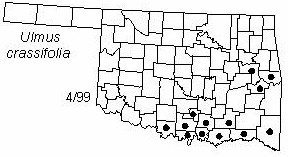
Tree to 18 m (60 ft) tall and 50 cm (18 in) in diameter with wide-spreading open crown. Bark light brown, divided into wide scaly ridges. Twigs thin, red-brown, finely hairy, often forming two flat corky ridges or wings on older twigs. Buds small, red-brown, covered with hairy scales, no terminal bud. Leaves alternate, lanceolate or elliptical, short-pointed or blunt, with the two sides of the rounded base unequal, 2.5-5 cm (1-2 in) long and about half as wide, margins doubly serrate, dark green and rough above, paler and soft-hairy below. Flowers in small clusters on leafless twigs, small, greenish or brownish, blooming in late Summer. Fruits in small clusters at leaf bases, elliptical samaras about 10 mm (0.4 in) long, with a broad wing, maturing in Fall.
Distribution: Native to the lower Mississippi Valley southwestward to northeastern Mexico.
Habitat: Hardwood forests, mostly on the coastal plain and near large rivers.
NWI status: FAC
Comment: Ulmus is the old Latin name for the elms; crassifolia refers to the rough thick leaves.
Distribution in Oklahoma: 
BACK
NEXT
RETURN TO INDEX
Last update: 9/21/99
 Go to Oklahoma Biological Survey Home Page
Go to Oklahoma Biological Survey Home Page
 Disclaimer
Disclaimer